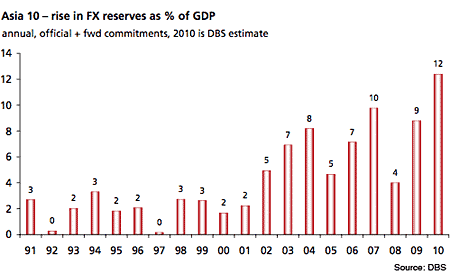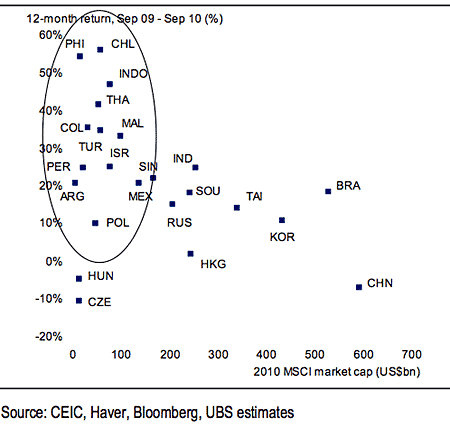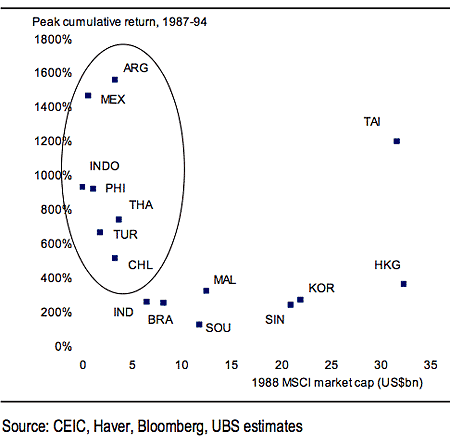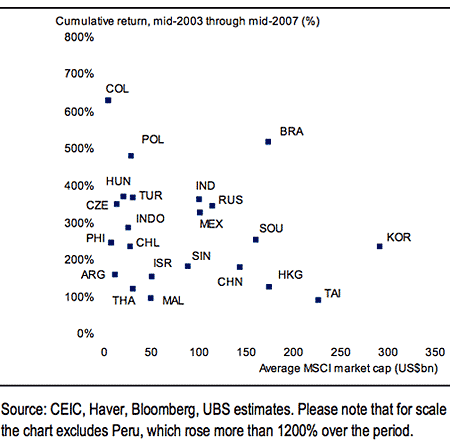Why Asia is worried about cheap money
Investors in the developed world are pouring money into emerging markets in search of better growth then they can get at home. That's pushing up currencies and asset prices, and there is every chance it could turn into a bubble. But there are still plenty of places where cheap foreign money is welcome, says Cris Sholto Heaton.

After my jaunt to Jakarta, I'm back in what's becoming a rather expensive city for British visitors.
The Singapore dollar has risen by 45% against sterling over the last three years. And frankly, that's probably much deserved. Singapore is one of the most creditworthy countries around. Its public finances are strong, and its annual inflation rate has only risen above 2% twice in the last 15 years.
Small wonder the most common question I get asked these days is how British investors can put some money into Singaporean dollars or other Asian currencies. And that's a topic I'll be covering soon I've been doing some comparison shopping on Singaporean banks and brokers while I'm in the area, and I'll be reporting back to you shortly.
MoneyWeek
Subscribe to MoneyWeek today and get your first six magazine issues absolutely FREE

Sign up to Money Morning
Don't miss the latest investment and personal finances news, market analysis, plus money-saving tips with our free twice-daily newsletter
Don't miss the latest investment and personal finances news, market analysis, plus money-saving tips with our free twice-daily newsletter
But this week, I want to take a look at this problem of cheap money and also give you an example of just one of the great opportunities I've been uncovering on the ground here
I came across a staggering figure this week, courtesy of analysts at Singaporean bank DBS. We all know that foreign investors are plunging back into emerging markets in search of better growth prospects than they can get at home.
However, it's not until you look at foreign exchange reserves that the sheer scale of this rush for emerging markets becomes clear. Most Asian central banks intervene in currency markets to some extent to keep their exchange rates reasonably stable. As a result, their currency reserves are quite a good indicator of money coming into the country (although of course they include exports as well as investment).
Since April 2009, Asia's foreign exchange reserves have risen by $962bn, or $2bn a day. Relative to GDP, this is the highest rate of inflows in the region's history.

And not everyone is happy about it. Some governments are concerned that it's pushing up their currencies and so hurting their exporters. Take Thailand. The baht has risen by almost 10% against a basket of trade-weighted currencies so far this year. Last week, the country removed a tax break that foreign investors received on bonds. And the finance minister said more measures would follow if there were signs of excess speculation.
Other economies aren't so concerned. Singapore is happy to go with the flow, for example. The country operates an unusual policy where the Singapore dollar is linked to a basket of foreign currencies and allowed to trade in a certain band around this basket value, on a gradually rising uptrend. Last week, the Monetary Authority of Singapore its equivalent of a central bank said the band would be widened and the rate of increase quickened slightly.
But they're certainly worried about what all this liquidity is doing to asset prices, and property in particular. The country has introduced new measures to try to cool the real estate market. Judging by what I've seen while I've been here, it may be having an effect. Hong Kong is trying to do the same, but so far seems to be having less of an impact, with sales there still looking robust.
The biggest rise is in the smallest markets
When it comes to stock markets, it's not hard to see what the wave of foreign money is doing. The chart below comes from Jonathan Anderson of UBS and shows the return over the last 12 months versus the size of each market.

As you can see, there's a strong negative relationship between the size of the market and the size of the move. In other words, the smaller the market, the bigger the move. This is especially clear if we exclude Eastern Europe, which is the most damaged and least in-favour emerging region.
Anderson points out something else that's significant. We've seen this before. The last time it happened was in the late 1980s and early 1990s, as the chart below shows.

Back then, the smallest markets generally saw the biggest gains.
However, in the big emerging markets boom earlier this decade, the same didn't hold true. As the third of Anderson's charts below shows, the same relationship isn't there size didn't make any real difference to the scale of the gains.

Is it Japan all over again?
One of the factors in the 1980s-1990s bubbles was abundant foreign inflows. Much of that came from Japan. After that bubble burst in 1990, Japanese money fled the country looking for better opportunities. That helped create the Southeast Asian bubble of the early and mid-1990s.
Today, the West is playing the role of Japan. In much of the developed world, rates are at rock bottom. If you are willing (and able) to borrow, money is cheap.
But where to put this money? Developed world bond yields offer no protection against inflation. Stock markets generally aren't cheap enough to be attractive. And businesses would rather invest where there is growth. All this creates an incentive for money to flow overseas, certainly among inflationists deflationists will continue to pile into bonds.
Expert tips for investing in Asia! Claim your FREE guides from MoneyWeek that include:
- How to go about investing to Asia
- Which brokers to use to buy foreign shares
So no wonder countries such as Thailand are worried about how Western money-printing could affect them. I don't think we'll see full-on capital controls to keep out investment, but we will see more and more efforts at calming 'hot money' inflows in the years ahead. Whether they will work is uncertain.
But foreign money isn't unwelcome everywhere. In Indonesia last week, the message that I kept hearing was that it's a good thing that foreigners want to invest there. People aren't blind to the dangers of hot money, and they are very keen to boost domestic investment, from individuals and pension funds. But they are pleased that foreigners are coming back after almost a decade in the wilderness following the Asian crisis.
This could turn into a bubble but not yet
Given that most success stories end in excess, there's a very good chance that if Asian economies continue to do well, this could all end in a bubble. But we're not there yet.
People are getting carried away in some areas. For example, I'm very optimistic about demand for industries such as fast-moving consumer goods and healthcare. But there's definitely scope for disappointment, due to the high valuations that investors are now putting on the high-profile names in these sectors. This is partly due to scarcity, since relatively few such stocks have the liquidity for major funds. Similar smaller and medium-sized firms are much more attractively priced.
But that happens in every market. For example, during the great US bull market of the 1950s and 1960s, fitted carpets became a brief mania. Every home was going to have one, and fitted carpet firms traded at prices that implied that America would be covered coast-to-coast in soft-pile oatmeal. Obviously, that bubble burst but the bull market carried on.
So while we'll see ups and downs in Asia, I expect their bull markets too will run for many years. Looking beyond stocks, I still don't see any signs that people are getting carried away. There was construction going on in Jakarta for example, but there's no forest of cranes. Indeed, there's so much still to be done that it could do with far, far more investment.
One example of Asia's potential
And the opportunities are there if you're prepared to look. Almost every day, I run across something that reminds me of quite how big some of these opportunities could be. As part of my research for my Asia Investor newsletter, I've been meeting a number of companies. They've thrown up some promising stories for example, I'm intending to bring subscribers an interesting healthcare play that pays a very solid yield in my next update next week.
But on Monday, I met with a company that's already featured in Asia Investor to get a detailed update on some parts of its business. I don't want to give away all the details because it's a relatively new recommendation and that wouldn't be fair to subscribers. But I want to share the outline with you as an example of just how much untapped potential remains in emerging markets.
Although the meeting was at its headquarters in Singapore, this firm's roots are in Indonesia, where it makes snacks. Its sales have been growing strongly, but the overall market is still only around a third as much per person as it is in wealthy Singapore. So it's obvious from the outset that there's good room for growth as incomes rise.
Obviously I knew this before I recommended the stock. But in the meeting, I learned a fact that I had never seen or heard mentioned before. This nationwide average disguises the fact that only a small part of Indonesia's 240 million population an estimated 15-20 million people actually currently consumes its product.
That's not due to cultural factors it's down to income. Even though this isn't a luxury good at all, most people don't yet have the discretionary income for eating these types of packaged snacks regularly. However, those that do must be heavy consumers perhaps four to five times as much as Singaporeans, based on those numbers above.
With incomes rising, more people will have some spare cash to spend. With the taste for this kind of product already embedded in the population, the market could see many, many years perhaps decades of extremely strong growth. And the best part is that this firm is utterly dominant in its sector, with a market share of getting on for 60% across its brands. It trades on a p/e of 15.5 times my (hopefully conservative) estimate for next year and still offers a yield of about 2%.
I can't find opportunities like that in the West. I could find them in Latin America or Africa but often accessing those shares is a problem and so is getting information. To me, Asia is unique for now in offering good capital markets and vast economic potential. That's a winning combination, which is why in the time you took to read this, millions more flowed into Asian assets.
This article is from MoneyWeek Asia, a FREE weekly email of investment ideas and news every Monday from MoneyWeek magazine, covering the world's fastest-developing and most exciting region. Sign up to MoneyWeek Asia here
Get the latest financial news, insights and expert analysis from our award-winning MoneyWeek team, to help you understand what really matters when it comes to your finances.
Cris Sholto Heaton is an investment analyst and writer who has been contributing to MoneyWeek since 2006 and was managing editor of the magazine between 2016 and 2018. He is especially interested in international investing, believing many investors still focus too much on their home markets and that it pays to take advantage of all the opportunities the world offers. He often writes about Asian equities, international income and global asset allocation.
Cris began his career in financial services consultancy at PwC and Lane Clark & Peacock, before an abrupt change of direction into oil, gas and energy at Petroleum Economist and Platts and subsequently into investment research and writing. In addition to his articles for MoneyWeek, he also works with a number of asset managers, consultancies and financial information providers.
He holds the Chartered Financial Analyst designation and the Investment Management Certificate, as well as degrees in finance and mathematics. He has also studied acting, film-making and photography, and strongly suspects that an awareness of what makes a compelling story is just as important for understanding markets as any amount of qualifications.
-
 ‘Why I have ditched my Help to Buy ISA for cash savings and the stock market’
‘Why I have ditched my Help to Buy ISA for cash savings and the stock market’Without the 25% bonus, my Help to Buy ISA is effectively redundant, says MoneyWeek writer Sam Walker.
-
 Is your inheritance tax allowance cut if you sell to downsize or sell your home to pay for care?
Is your inheritance tax allowance cut if you sell to downsize or sell your home to pay for care?Downsizing relief is a little-known benefit that could save your loved ones tens of thousands of pounds in inheritance tax after you’ve died.
